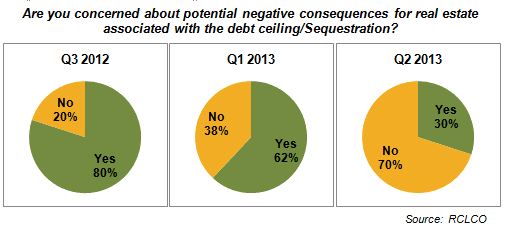Sequestration: Myth or Monster?

With the first round of cuts from the dreaded Sequester going into effect, industry professionals are less concerned than ever about its potential negative consequences. Less than a year ago, 80% of real estate market participants reported concern about the upcoming consequences of Sequestration and the fiscal cliff. In the most recent survey, just 30% of respondents are still concerned. Has the sequester monster become all bark and no bite?

According to RCLCO’s most recent Market Sentiment Survey, it doesn’t matter who you ask, it matters where you ask. In the New England and Baltimore/DC/Virginia regions, nearly 60% of professionals are concerned—that’s twice the national average. Meanwhile, just 18% of respondents in California, the Pacific Northwest, Southwest (AZ, NM, NV), South Central, and Texas are worried. So, what gives? Are the west coasters just too busy with their sunshine and surf boards to pay attention to the news?

It’s possible. But a more likely explanation lies in the uneven impact of Sequestration across industries, and thus geographies. Fifty percent of the nine-year sequester cuts, or $492 billion, are required to come from defense spending, likely to include drastic decreases in weapons purchases, base operations, and construction work.1 In 2013 alone, defense cuts will reach $42.7 billion. Outside of defense, many research institutions, such as the National Institutes of Health, Centers for Disease Control and Prevention, NASA, and National Science Foundation, will also see cuts. Although the Sequester will not technically cut federal employees’ salaries, it is resulting in some furloughs—essentially unpaid time off.2
These massive cuts across the federal budget will likely begin to cause nationwide consequences as they continue to take effect, but the high concentration of federal government jobs, government contractors, military bases, research labs, and universities in New England and Baltimore/DC/Virginia make those regions particularly vulnerable. According to the Washington Post, Maryland is among the states “facing the deepest cuts.”3 Although most of the nation is only currently within earshot of the bark of the sequester monster, some, if not all, regions may soon be feeling the bite.
Even with the Sequester’s effects looming, the majority of real estate market participants expect key economic and real estate market indicators to slightly to moderately increase over the six to 12 months. Although very few respondents anticipate declining market fundamentals, very few anticipate significant improvements.

On the positive side, land and home prices, and to a lesser extent retail and industrial rents, are expected to increase moderately over the next six to 12 months. However, real estate industry participants expect to see sharp increases in interest and cap rates, which could potentially adversely affect the resurgent for-sale housing market and lower values for income producing properties.

These expectations are quite consistent with the notion that real estate industry sectors have fully turned the corner from the downturn. With strong market fundamentals and growing momentum, RCLCO anticipates growth to continue through 2013 and beyond. With the Sequestration beginning to make its mark, it is important to also factor in its potential consequences, especially in markets where employment is heavily dependent on federal jobs, defense, and research.
1According to Bipartisan Policy Center’s report “Everything You Want to Know About the Sequester (and more)”
2Matthews, Dylan. “The Sequester: Absolutely everything you could possibly need to know, in one FAQ.” The Washington Post, February 20,2013.
3Fletcher, Michael A. “Sequester brings pain to the long-term jobless.” The Washington Post, July 2, 2013.
Article and Research prepared by Len Bogorad, Managing Director and Trish Kennelly, Associate.
RCLCO provides real estate economics, strategic planning, management consulting, and implementation services to real estate investors, developers, financial institutions, public agencies, and anchor institutions. Our real estate advisors help clients make the best decisions about real estate investment, repositioning, planning, and development.
RCLCO’s advisory groups provide market-driven, analytically based, and financially sound solutions. RCLCO’s Strategic Planning Advisory Group produced this newsletter. Interested in learning more about RCLCO’s services? Please visit us at www.rclco.com/strategic-planning.
Related Articles
Speak to One of Our Real Estate Advisors Today
We take a strategic, data-driven approach to solving your real estate problems.
Contact Us









